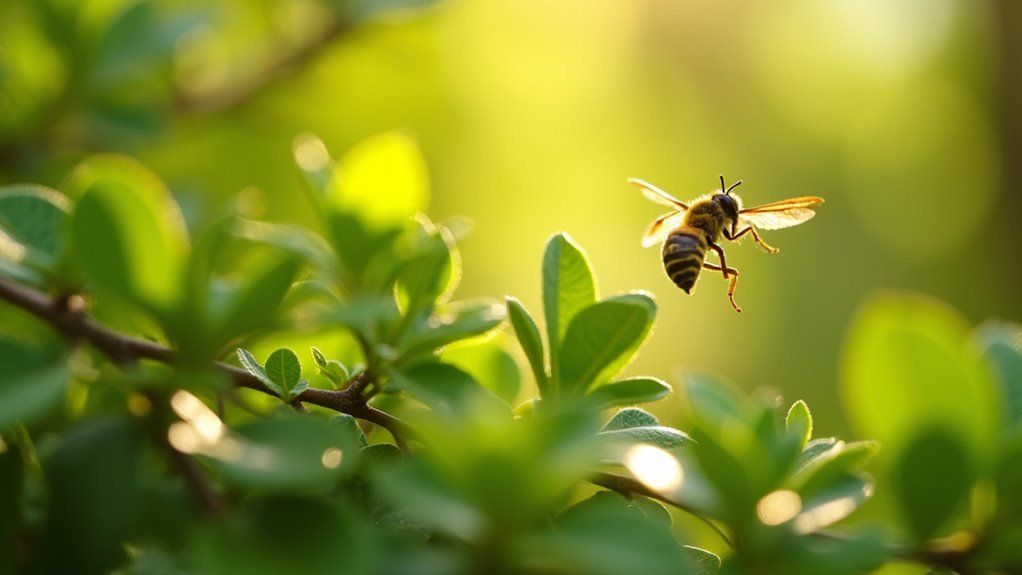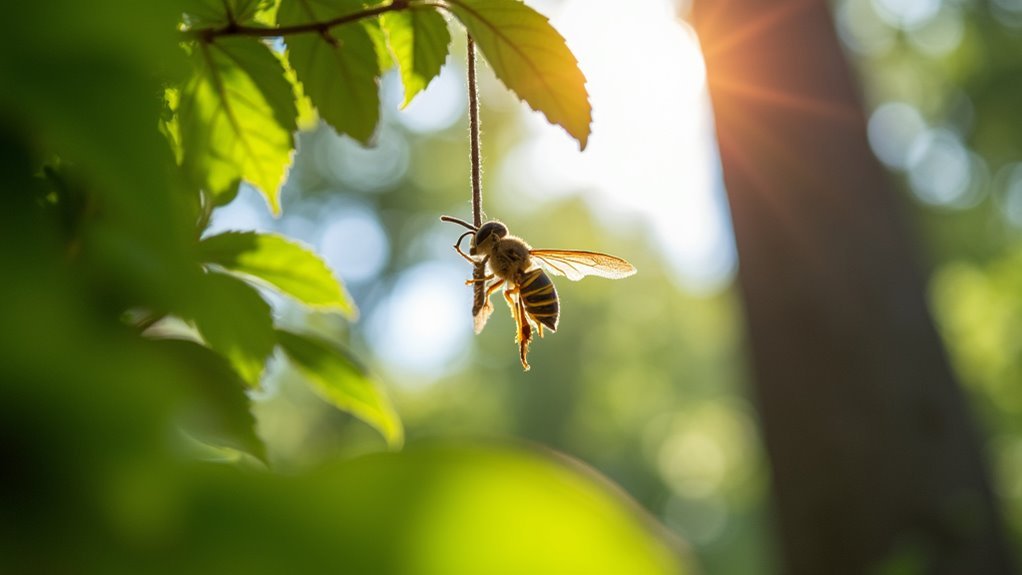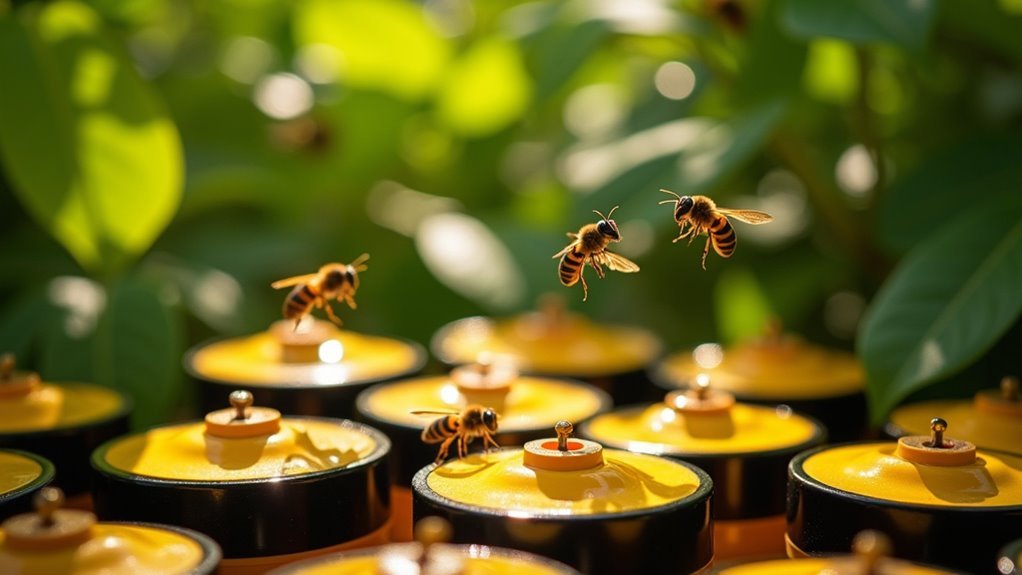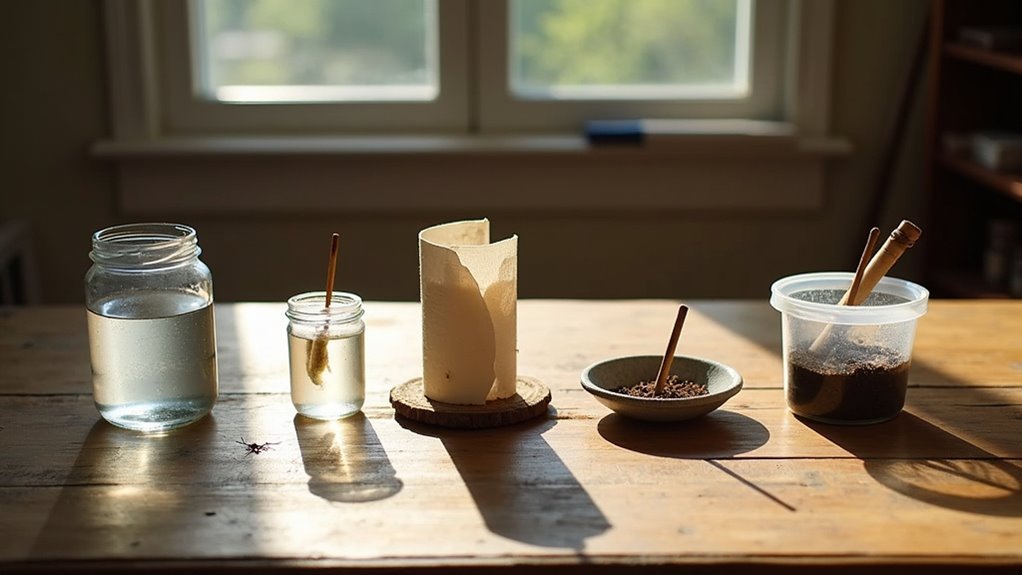Trap placement determines your hornet control success because hornets follow predictable flight patterns 4-6 feet above ground, so you’ll need to position traps at 2-3 and 5-6 foot heights along these routes. You should place traps at least 20 feet from high-traffic areas while staying near food sources and water for scent distribution. Strategic positioning along flight paths, combined with seasonal adjustments and proper distance from competing attractants, transforms ineffective traps into powerful barriers that’ll protect your property year-round.
Understanding Hornet Behavior and Flight Patterns

When you’re setting traps for hornets, understanding their flight behavior becomes your most valuable tool for success. Hornets navigate using visual cues and create mental maps of their territory, so strategic trap placement along their established flight paths dramatically improves capture rates.
You’ll find these insects typically fly between 4 to 6 feet above ground, making this your target height range for positioning traps.
Hornet behavior changes throughout the day and seasons, affecting your success. They prefer sunny spots during morning hours but shift to shaded areas in the afternoon.
Seasonal dietary shifts also influence their preferences – protein-based attractants work best in early summer, while sugary options become more effective in late fall. Understanding these patterns guarantees ideal results for your control efforts.
Optimal Distance From High-Traffic Areas
Strategic trap placement requires careful evaluation of distance from areas where people gather regularly. You should position your hornet traps at least 20 feet away from high-traffic areas to minimize sting risks and maximize effectiveness. This distance prevents hornets from becoming a nuisance in recreational zones while still intercepting them before they reach gathering spaces.
When determining trap placement, you’ll want to take into account prevailing wind direction to enhance scent distribution of attractants toward high-traffic areas.
Strategic placement of multiple effective traps around your property’s perimeter creates a protective barrier that greatly reduces hornets entering spaces where people congregate. Positioning traps away from competing food sources also increases their likelihood of attracting hornets, making your control efforts more successful overall.
Strategic Positioning Near Food Sources and Water

You’ll maximize your hornet trap effectiveness by positioning them strategically near the food sources and water features that naturally draw these pests to your property.
Focus your placement around outdoor dining areas where sugary drinks and protein-rich foods create irresistible attractants, especially during late summer months.
Don’t overlook water features like bird baths, ponds, and fruit trees, as hornets require both hydration and the sweet substances these locations provide.
Outdoor Dining Areas
Although outdoor dining areas present unique challenges for hornet control, proper trap placement can effectively protect your guests while maintaining an enjoyable atmosphere.
Position your wasp traps 15-20 feet away from outdoor dining areas to intercept hornets before they reach food sources. This distance prevents competition between your trap’s attractant scents and dining aromas while minimizing sting risks.
Strategic positioning enhances effectiveness greatly. Place traps near water features and flowering plants that naturally attract hornets, creating interception points before they investigate your dining space.
Consider prevailing wind direction when positioning traps—you’ll want bait scents carried toward dining areas to maximize capture rates.
Adapt placement to hornet activity patterns by choosing sunny morning locations and shaded afternoon spots. Regular bait monitoring ensures continued effectiveness in high-traffic areas.
Water Feature Proximity
Water features create prime hunting grounds for hornets, making trap placement near these areas particularly effective for population control.
You’ll want to position your traps within 15-20 feet of water sources to create a strategic barrier that intercepts hornets before they reach gathering areas. Hornets are naturally attracted to water features for hydration, especially during hot months, and these locations also draw insects that hornets hunt for food.
The proximity to water enhances your trap’s scent distribution, making them more effective at luring hornets from their habitats.
You should monitor activity around these water features regularly to guide trap placement adjustments. This strategic approach helps reduce populations by capitalizing on hornets’ natural behaviors and movement patterns around essential water sources.
Fruit Tree Placement
Since fruit trees become magnets for hornets during late summer and fall harvest seasons, positioning traps strategically around these areas creates an essential line of defense for your property.
These trees serve as a primary food source, making them ideal locations for hornet interception.
Optimal placement around fruit trees requires three key considerations:
- Distance: Position traps 15-20 feet away from trees to intercept hornets before they reach your harvest area.
- Environment: Choose sunny locations near fruit trees, as hornets prefer warmer foraging environments.
- Enhancement: Place traps near water features adjacent to fruit trees, since hornets need hydration.
The scent of overripe fruit naturally draws hornets, so your traps can capitalize on this attraction while protecting both your fruit harvest and family safety.
Height and Mounting Considerations for Maximum Effectiveness

When you’re positioning hornet traps, mounting height plays an essential role in determining their effectiveness.
You’ll want to place traps at 2-3 feet and 5-6 feet elevations, as hornets typically follow established flight paths within these ranges. This strategic trap placement considerably improves capture rates by intercepting hornets as they navigate between feeding areas and nests.
Mount your traps on poles or hang them from tree branches to target hornets approaching from natural habitats.
Position them at least 20 feet away from outdoor activity zones to minimize human encounters while maintaining effectiveness. Choose locations with morning sun and afternoon shade for ideal visibility during peak hornet activity.
Monitor your traps regularly and adjust heights seasonally, as changing nesting behaviors may shift their flight patterns throughout the year.
Seasonal Placement Adjustments Throughout the Year
You’ll need to shift your trap placement strategy as seasons change to match hornet behavior patterns.
In spring, focus on sunny, sheltered spots where emerging queens establish new colonies, while fall requires positioning traps near entry points and warm walls where hornets seek winter shelter.
This seasonal adjustment approach targets hornets when they’re most vulnerable and prevents colony establishment or winter survival.
Spring Queen Targeting
While winter’s grip loosens and temperatures begin to rise, you’ll need to focus your trapping efforts on intercepting queen hornets as they emerge from hibernation.
Early spring presents your best opportunity to prevent entire colonies from establishing, as queens are less aggressive and more vulnerable while searching for nesting sites.
Strategic trap placement during this critical period requires targeting three key locations:
- Sunny, sheltered areas where queens seek warmth and protection from lingering cold spells
- Near flowering plants that provide essential food sources for energy-depleted queens
- 15-20 feet from human activity zones to safely intercept hornets without risking stings
Monitor and adjust your trap locations throughout spring as queens adapt their flight patterns, ensuring you’re intercepting hornets before they establish nests.
Fall Entry Prevention
As autumn approaches and temperatures drop, hornets shift their behavior from colony expansion to seeking winter shelter, making this season essential for preventing home invasions.
You’ll need to adjust your trap placement strategy by positioning traps near potential entry points like doorways and windows to intercept hornets before they enter your home.
Focus trap placement along sunny walls and entry routes where hornets actively search for nesting sites and food sources.
Even as their activity decreases in cooler weather, maintaining traps in high-traffic areas helps monitor remaining populations.
Remember to regularly inspect and refresh your bait, as hornets become less attracted to old attractants during fall.
Consider pairing traps with fake hornet nests to deter nearby nesting through perceived competition.
Common Placement Mistakes That Reduce Trap Success
Even experienced homeowners often sabotage their hornet control efforts by making critical placement errors that actually work against trap effectiveness.
Poor trap placement decisions can transform your control strategy from solution to problem, reducing effectiveness when you need results most.
Three critical mistakes undermine success:
- Positioning traps too close to outdoor activity areas – Places traps within 20 feet of patios or decks, causing hornets to swarm around people instead of entering traps.
- Ignoring seasonal hornet behavior changes – Fails to move traps from shaded summer spots to sunny spring locations or fall entry points.
- Setting single traps instead of multiple traps – Limits coverage area and misses infestation scope.
You’ll also attract wasps ineffectively if you don’t monitor and refresh bait regularly, letting stale attractants sit unused.
Frequently Asked Questions
Where Do You Hang Hornet Traps?
You should hang hornet traps at least 20 feet from outdoor activity areas, near bushes and trees where hornets naturally gather. Use multiple traps around your property’s perimeter for better coverage.
Do Hornet Traps Really Work?
Yes, you’ll find hornet traps work effectively when you place them strategically near nesting sites, use seasonal baits, and refresh them weekly. They won’t eliminate infestations completely, but they’ll considerably reduce populations.
Why Do Yellow Jacket Traps Need to Be 20 Feet Away?
You’ll want traps 20 feet away because closer placement attracts yellow jackets to your activity areas, increasing sting risk. This distance intercepts them along flight paths before they reach people or food sources.
Do Trapped Wasps Attract More Wasps?
Yes, trapped wasps can attract more wasps. When you trap wasps, they’ll release danger pheromones that signal other wasps. You’re fundamentally creating a beacon that draws curious wasps to investigate the area.
In Summary
Strategic trap placement isn’t just about setting them up—it’s about understanding your enemy. You’ll achieve the best results when you position traps at the right height, distance, and location while avoiding common mistakes that sabotage your efforts. Remember to adjust your placement strategy as seasons change and hornet behavior shifts. Master these fundamentals, and you’ll transform your property from a hornet haven into an effectively protected space.





Leave a Reply